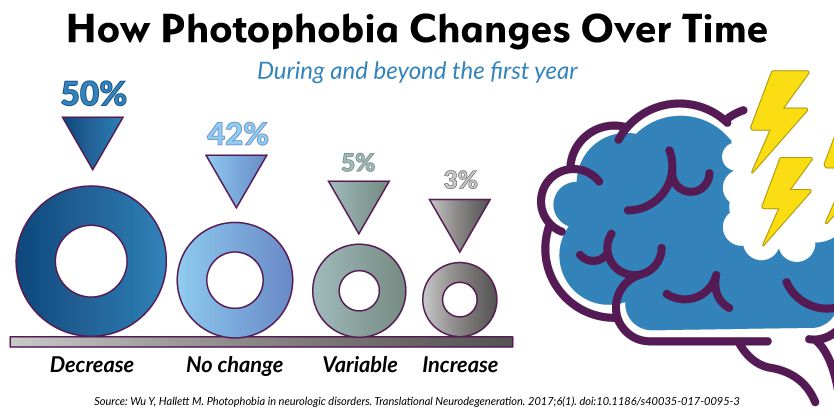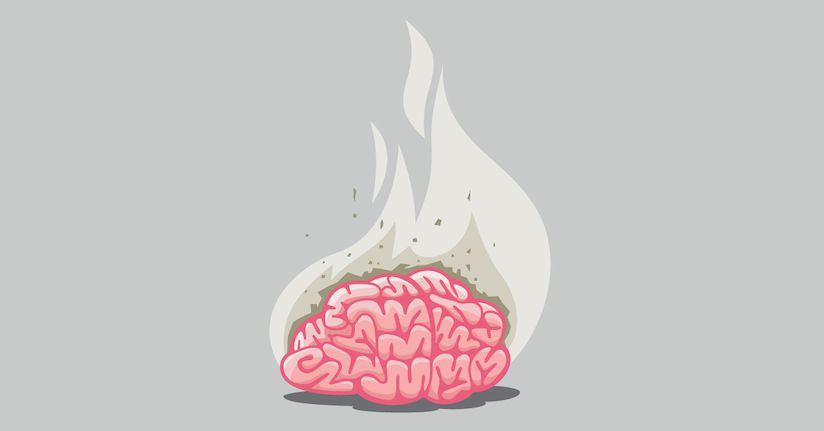Photophobia, Light Sensitivity after Traumatic Brain Injury (TBI)
Sustaining a traumatic brain injury (TBI) can be one of the most disruptive events for a person to endure. Aside from the obvious trauma that occurs to the brain, these injuries can lead to a multitude of neurological and sensory symptoms, including photophobia or light sensitivity.
How often does it follow TBI? What is the long-term prognosis and quality of life for TBI-related photophobia? What can help improve the symptom for patients? We answer these questions and more to help you understand how light sensitivity impacts traumatic brain injuries.

Light Sensitivity and Concussion, Mild TBI
Many of us are familiar with the term “concussion,” probably stemming from its usage in competitive sports like professional football. In clinical terms, concussion is graded as the least severe of traumatic brain injuries—hence the term mild TBI—but that does not necessarily mean the symptoms are any less impactful. In fact, sensitivity to light has been shown to affect approximately half of individuals who experience a concussion.1,2 Although photophobia can occur in numerous other conditions and generally all people have some level of light sensitivity, people with mild traumatic brain injuries may be as much as FIVE TIMES more likely to suffer the effects of light intolerance versus non-TBI sufferers.2
Light sensitivity can occur just about any time after a concussion, but researchers suggest that it may be most common 1-3 weeks after the injury. In addition, evidence shows that people who experience these types of injuries have a lower threshold for light, meaning that the relative brightness of light sources plays a role in light-induced pain.3
The way in which a person acquires the concussive brain trauma may influence whether they experience light sensitivity as well. For example, veterans who sustained a concussion from a blast (even without direct trauma to the eye) were more likely to have photophobia than non-blast concussions.4 But make no mistake: any mild traumatic brain injury—whether it’s from a fall, a hit to the head, or the result of military service or sports—can lead to these complications.
Post-Concussion Syndrome and Persistent Light Sensitivity
While light sensitivity symptoms typically resolve through the course of the concussion recovery process for many patients, they can persist for weeks, months and even years after the original trauma. This often reflects the onset of a new diagnosis, post-concussion syndrome, in which a history of mild TBI is followed by ongoing symptoms.
Curiously, photophobia is not part of the diagnostic criteria for post-concussion syndrome, although other sensory disruptions (e.g. sensitivity to noise) have been included. Headache is also part of certain clinical definitions of post-concussion syndrome and is frequently associated with migraine-like features such as light sensitivity.5
Studies have suggested that around 10% of people with post-concussion syndrome have these sensory sensitivities, however that does not necessarily connect with other research showing that nearly one-third of concussed patients have light sensitivity after one month. More than 20% continue to have these symptoms at one year too.5,6 At minimum, it is believed that patients with these complaints in the early phase of the recovery may predict their long-term impact.
Light Sensitivity and Moderate, Severe TBI
Much like mild TBI, brain injuries rated as moderate or severe can also lead to light sensitivity. While we have less clinical data defining the broader likelihood of photophobia for people with more serious injuries, one small study showed that approximately 40% of people with moderate or severe TBI had the symptom.4
Those traumas featuring a loss of consciousness (a hallmark indicator of moderate/severe TBI) frequently translate to more serious and persisting symptoms as well, including sensitivity to light. There continues to be a lack of solid evidence regarding the long-term prospects of these symptoms, but it is possible that sensory sensitivities may develop anew as late as 2-3 years post injury for a quarter of patients.7 And of course, it is understood that many become lifelong complaints for TBI survivors.
Duration of Light Sensitivity Symptoms
The truth is we don’t really know how long photophobia will last after a brain injury, and the evidence we do have paints a complex picture reflective of the intricacies of TBI. One study showed that two-thirds of veterans with a blast-induced injury had visual complaints six years later, with light sensitivity being the most common.8 For some, it becomes a chronic symptom that remains with them for the rest of their lives.

On the other hand, light and noise sensitivity were among the least likely to be present at 10 years after the injury for a small group of TBI survivors.9 To top it all off, a relative split of concussion patients experienced a reduction in photophobia (50%) over the years while a similar percentage (42%) had no change; luckily, only a fraction felt their symptoms had worsened.10
Those who develop post-traumatic headache or migraine may see a greater risk for long-term sensitivity to light. After three years, TBI-related headache can affect approximately half of patients and may indicate that it has become a chronic impairment.11 As a likely cause of sensory problems, it only makes sense that accompanying photophobia can persist for as long as the headaches.
Causes of TBI-Related Light Sensitivity
The cause of photophobia remains somewhat of a mystery, especially when it follows traumatic brain injuries. That’s probably why researchers have relied on existing explanations of light sensitivity in other conditions, namely migraine and headache disorders. We do know that light sensitivity after TBI is typically neurological in origin because patients can display symptoms even without any ocular trauma. In fact, it appears that the trigeminal pathway—which controls sensory inputs, impacts pain sensation, and is a suspected cause of photophobia—is affected or compromised as a result of the injury.12,13
The connection to post-TBI or post-concussion headaches cannot be overlooked either. Headaches dominate post-injury complaints, and over 70% of patients have been shown to have post-traumatic headache during the first year—making it perhaps one of the main causes of photophobia after TBI.14
These headaches often look a lot like migraine because of the non-headache symptoms that manifest, namely light and sound sensitivity, dizziness, aura and more. Photophobia, in particular, is a probable indicator of post-traumatic migraine, and people with headache or migraine symptoms due to TBI have lower tolerance for bright light.15 And certain wavelengths of light may aggravate TBI-caused photophobia symptoms, similar to how it can trigger them in migraine too.
RELATED: 5 Types of Chronic Headaches and Migraines after TBI ➜
Impact of Light Sensitivity
People with light sensitivity typically experience a decline in quality of life, particularly if it becomes a chronic problem. Those who develop the symptom as a result of a traumatic brain injury also deal with the frustrations and pain that comes with it. If they face other sensory complications or have related comorbidities (such as sleep disorders, ocular disorders or migraine), the effect can be even more pronounced.

Light sensitivity makes it harder to participate in the same daily activities that people with healthy brains get to enjoy. Going to the grocery store with fluorescent lights, viewing a smartphone screen, or taking a hike under the bright sun can become a triggering episode for a light-sensitive person.
Treatment Options
For such a disabling symptom, current therapeutics and treatment options for photophobia leave much to be desired. But relief is available!
First, it is becoming increasingly important to avoid what some have called “total rest” after a brain injury. While it may make sense to take 2-3 days to get through the most intense acute symptoms, avoiding all activities for several days or weeks can actually worsen light sensitivity (and other symptoms) over time as well as hinder recovery outcomes.
Wearing sunglasses indoors is a natural extension of this avoidance strategy, which is why leading authorities from the American Optometric Association and other organizations recommend weaning off the practice as soon as possible. Screen time recommendations do not support an “all or none” approach either. Ultimately, it is better to gradually increase your activity and exposure to external stimuli as long as it does not make you feel worse.
Tinted lenses also offer a promising solution for TBI-related photophobia, especially given that blue light has been shown to generally aggravate general photophobia and, in certain instances, specifically brain injury-related light sensitivity. Certain brands, particularly with the FL-41 tint, offer greater blue light protection and already have clinical support for improving photophobia in migraine and other neurological disorders. Many rehabilitative and headache specialists currently recommend this tint for patients with brain injuries. Other color tints may also be helpful in the post-injury recovery process, although we must continue to advocate for more directed research on the potential benefits of light-filtering glasses.16,17
For outdoor sensitivities, dark and polarized sunglasses and other light-blocking methods (e.g. wearing wide-brimmed hats) can provide the best defense outside. You can also get specific FL-41 sunglasses that block the right wavelengths of triggering blue light—which typically is found in higher concentrations in natural light versus artificial light—such as TheraSpecs. Finding frames that give comprehensive top and side coverage also can make a huge difference in the overall effectiveness of your sunglasses against bright sunlight.
Lastly, diagnosing comorbid conditions (such as migraine) and treating them with proven medications and devices has repeatedly yielded improvements to the most bothersome symptoms. This includes photophobia, phonophobia (sound sensitivity) and more.
References:
1Garbus C. Understanding photophobia in mTBI. American Optometric Association. https://www.aoa.org/news/clinical-eye-care/diseases-and-conditions/understanding-photophobia-in-mtbi?sso=y. Published January 19, 2021. Accessed February 23, 2021.
2Capó-Aponte JE, Urosevich TG, Temme LA, Tarbett AK, Sanghera NK. Visual Dysfunctions and Symptoms During the Subacute Stage of Blast-Induced Mild Traumatic Brain Injury. Military Medicine. 2012;177(7):804-813. doi:10.7205/milmed-d-12-00061.
3Waddell PA, Gronwall DM. Sensitivity to light and sound following minor head injury. Acta Neurol Scand. 1984;69(5):270-276. doi:10.1111/j.1600-0404.1984.tb07812.x
4Goodrich GL, Flyg HM, Kirby JE, Chang C-Y, Martinsen GL. Mechanisms of TBI and Visual Consequences in Military and Veteran Populations. Optometry and Vision Science. 2013;90(2):105-112. doi:10.1097/opx.0b013e31827f15a1.
5Polinder S, Cnossen MC, Real RG, et al. A Multidimensional Approach to Post-concussion Symptoms in Mild Traumatic Brain Injury. Frontiers in Neurology. 2018;9. doi:10.3389/fneur.2018.01113.
6Bedaso A, Geja E, Ayalew M, Oltaye Z, Duko B. Post-concussion syndrome among patients experiencing head injury attending emergency department of Hawassa University Comprehensive specialized hospital, Hawassa, southern Ethiopia. The Journal of Headache and Pain. 2018;19(1). doi:10.1186/s10194-018-0945-0.
7Brickell TA, Lange RT, French LM. Three-year outcome following moderate-to-severe TBI in U.S. military service members: a descriptive cross-sectional study. Mil Med. 2014;179(8):839-848. doi:10.7205/MILMED-D-14-00016
8Magone MT, Cockerham GC, Shin SY. Visual Dysfunction in Combat-related Mild Traumatic Brain Injury—A Review. US Neurology. 2013;09(01):61. doi:10.17925/usn.2013.09.01.61.
9O'Connor C, Colantonio A, Polatajko H. Long term symptoms and limitations of activity of people with traumatic brain injury: a ten-year follow-up. Psychol Rep. 2005;97(1):169-179. doi:10.2466/pr0.97.1.169-179
10Wu Y, Hallett M. Photophobia in neurologic disorders. Translational Neurodegeneration. 2017;6(1). doi:10.1186/s40035-017-0095-3.
11Ahman S, Saveman BI, Styrke J, Björnstig U, Stålnacke BM. Long-term follow-up of patients with mild traumatic brain injury: a mixed-method study. J Rehabil Med. 2013;45(8):758-764. doi:10.2340/16501977-1182
12Likova L, Tyler CW. When light hurts: Brain-morphometry in concussion photophobia. Investigative Ophthalmology & Visual Science. 2018;59(9).
13Diel RJ, Mehra D, Kardon R, Buse DC, Moulton E, Galor A. Photophobia: shared pathophysiology underlying dry eye disease, migraine and traumatic brain injury leading to central neuroplasticity of the trigeminothalamic pathway. British Journal of Ophthalmology. 2020. doi:10.1136/bjophthalmol-2020-316417.
14Hoffman JM, Lucas S, Dikmen S, et al. Natural history of headache after traumatic brain injury. J Neurotrauma. 2011;28(9):1719-1725. doi:10.1089/neu.2011.1914
15Jarvis N, Starling AJ, Schwedt TJ. Photophobia symptoms and visual pain thresholds in posttraumatic headache after mild traumatic brain injury. Neurology. 2018;91(23 Supplement 1). doi:10.1212/01.wnl.0000550668.55103.10.
16Clark J, Hasselfeld K, Bigsby K, Divine J. Colored Glasses to Mitigate Photophobia Symptoms Posttraumatic Brain Injury. J Athl Train. 2017;52(8):725-729. doi:10.4085/1062-6050-52.4.04
17Lynch JM, Anderson M, Benton B, Green SS. The gaming of concussions: a unique intervention in postconcussion syndrome. J Athl Train. 2015;50(3):270-276. doi:10.4085/1062-6050-49.3.78
TheraSpecs Glasses for Light Management
Try our light-filtering glasses and stay protected against harsh light from screens, fluorescents, LEDs, unwanted blue light, bright sunlight, flashing lights, and more.





